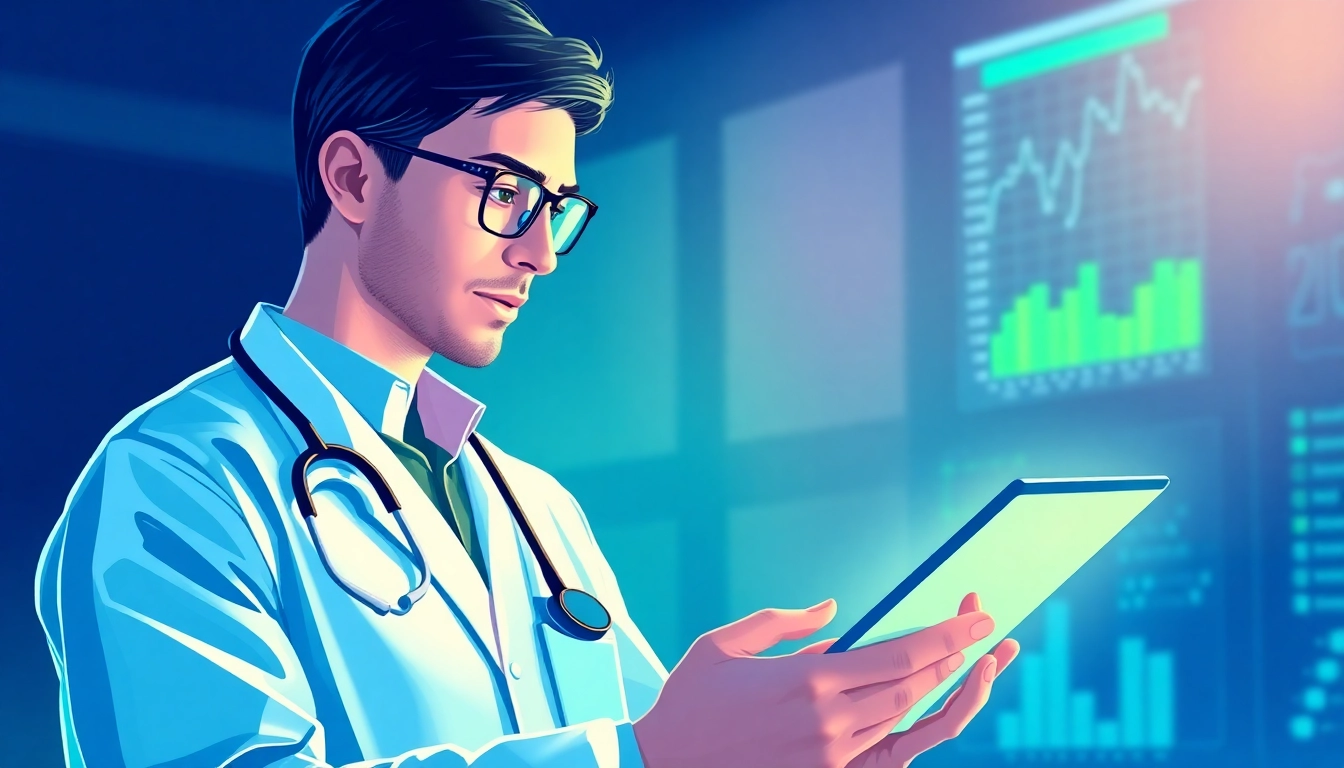Understanding the Foundations of Health Informatics
Health informatics is a rapidly evolving field that lies at the intersection of healthcare, information technology, and communications. The need for effective data management in healthcare environments has never been more crucial. As healthcare systems continue to adopt advanced technologies, understanding how to utilize data to enhance patient care becomes paramount. Organizations looking to leverage the benefits of informatics can explore resources such as https://www.informaticsview.com for insights and guidance on these transformative solutions. In this section, we will explore the core concepts that define health informatics, including its definition, the importance of data in healthcare, and the technologies that make it possible.
Definition and Scope of Informatics
Informatics can be broadly defined as the study of how technology can be used to manage and analyze information. In healthcare, this translates to using data to support, improve, and innovate patient care processes. The scope of health informatics includes a wide range of activities, from the development of electronic health records (EHRs) to improving the workflow of clinical decision support systems (CDSS). According to the American Medical Informatics Association (AMIA), health informatics can be viewed as a scientific discipline that applies principles from various fields, including computer science, cognitive science, and information science, to healthcare.
The Importance of Data in Healthcare
Data is often described as the new oil, driving various industries, and healthcare is no exception. In the context of health informatics, data plays a critical role in decision-making processes. The ability to collect, analyze, and act on healthcare data can lead to enhanced patient outcomes, reduced costs, and improved operational efficiencies. Well-managed data helps healthcare providers track patient health, predict disease outbreaks, personalize treatment plans, and monitor public health trends. Moreover, with the rise of big data analytics and machine learning, the potential for uncovering insights from vast datasets is significant, providing opportunities for innovative approaches to diagnosis and treatment.
Core Technologies in Health Informatics
A variety of technologies are foundational to health informatics, enabling the collection, storage, and analysis of healthcare data. Key technologies include:
- Electronic Health Records (EHRs): Digital versions of patients’ paper charts that streamline data management and accessibility.
- Health Information Exchange (HIE): Enables the sharing of patient information across different healthcare organizations.
- Clinical Decision Support Systems (CDSS): Provides healthcare professionals with patient-specific assessments and recommendations.
- Telemedicine Solutions: Facilitates remote patient consultations using audio-visual technology, enhancing access to care.
- Wearable Health Technologies: Devices that monitor various health metrics and send data to healthcare providers for analysis.
Applications of Informatics in Healthcare
Health informatics encompasses a broad range of applications that significantly impact patient care and healthcare operations. These applications revolutionize how healthcare providers interact with patients, manage information, and make clinical decisions. In this section, we’ll delve into some of the primary applications of health informatics in the healthcare industry.
Electronic Health Records (EHRs) and Their Impact
Electronic Health Records (EHRs) are arguably one of the most significant advancements in health informatics. They provide a digital format for recording patient health information, which enhances accessibility and improves care coordination. EHRs ensure that all healthcare providers involved in a patient’s care have access to comprehensive and up-to-date medical data, fostering improved communication and collaboration.
The impact of EHRs extends beyond mere data management; they have been shown to reduce medication errors, streamline scheduling processes, and optimize billing practices. Moreover, many EHR systems integrate clinical decision support tools to help clinicians adhere to best practices and guidelines, ultimately improving patient outcomes.
Clinical Decision Support Systems (CDSS)
Clinical Decision Support Systems (CDSS) are innovative tools that assist healthcare professionals in making informed decisions based on patient-specific data. CDSS utilizes algorithms, rules, and clinical knowledge to evaluate patient information and provide actionable recommendations during the diagnostic and treatment process.
These systems can alert providers to potential drug interactions, suggest preventative measures, or flag abnormal lab results for further examination. By integrating CDSS into routine practices, healthcare facilities can enhance the quality of care while reducing the likelihood of errors, ensuring that patients receive evidence-based recommendations tailored to their unique health histories.
Telemedicine and Remote Patient Monitoring
Telemedicine has emerged as a transformative force in healthcare, especially in the context of the COVID-19 pandemic. This technology allows healthcare providers to offer services remotely, utilizing video conferencing, phone calls, and mobile applications to connect with patients. Telemedicine not only expands access to care, particularly in rural or underserved areas, but it also allows for timely interventions and ongoing patient management.
Remote patient monitoring, often integrated with telehealth solutions, utilizes digital devices to capture real-time patient data, such as heart rates or glucose levels, which can then be transmitted to healthcare providers. Such innovations empower patients to manage their health proactively while enabling providers to monitor chronic conditions effectively and intervene when necessary.
Challenges in Implementing Health Informatics
Despite the numerous benefits of health informatics, various challenges must be addressed to optimize implementation within healthcare systems. Understanding these challenges is crucial for successfully integrating technologies and ensuring that they serve their intended purpose. This section examines some of the common obstacles organizations face when deploying informatics solutions.
Data Privacy and Security Concerns
One of the most pressing issues in health informatics is safeguarding patient data. As healthcare organizations collect vast amounts of sensitive information, they also become prime targets for cyberattacks. Ensuring data privacy and security is paramount to maintain patient trust and comply with regulations like the Health Insurance Portability and Accountability Act (HIPAA).
Organizations must implement robust cybersecurity measures, including encryption, access controls, and regular audits, to protect sensitive patient information. Additionally, educating staff about data protection best practices is vital to help mitigate risks and prevent breaches.
Interoperability Issues Among Systems
Interoperability, or the ability of different systems to communicate and exchange data seamlessly, is crucial for effective health informatics. Unfortunately, many healthcare organizations still rely on disparate systems that fail to integrate, leading to inefficiencies and fragmented patient care. The lack of standardization in data formats among EHRs and other healthcare technologies can hinder information sharing, complicating care coordination.
To overcome these interoperability challenges, healthcare organizations must invest in technologies that adhere to common standards, such as Fast Healthcare Interoperability Resources (FHIR). Collaborative efforts across institutions can help streamline data sharing and facilitate a more cohesive healthcare experience for patients.
Educating Healthcare Professionals on New Technologies
The introduction of new technologies often necessitates a cultural shift within healthcare organizations. Providers may be resistant to change, especially if new tools significantly alter their workflows. Educating healthcare professionals on the benefits and functionalities of informatics technologies is essential for fostering acceptance and encouraging adoption.
Training programs, workshops, and ongoing support can facilitate skill development and help staff feel comfortable utilizing new systems. Establishing a culture that values innovation and continuous learning is crucial for overcoming resistance to change and ensuring that informatics solutions are embraced effectively.
Best Practices for Effective Health Informatics Integration
Successfully integrating health informatics into healthcare organizations requires a strategic approach, considering both technical and human factors. This section outlines best practices to enhance the implementation process, ensuring that the transition is smooth and effective.
Strategies for Successful System Adoption
Adoption of new informatics systems can be challenging, but a thoughtful strategy can greatly facilitate the process. First, a comprehensive needs assessment should be conducted to identify gaps and challenges that the new system aims to address. Based on this assessment, stakeholders should collectively determine selection criteria for technologies that best fit the needs of the organization.
Furthermore, engaging end-users early in the system selection process promotes buy-in and ensures that the chosen solution aligns with workflows. Piloting the system in phases allows for adjustments before full-scale implementation, which can help mitigate unforeseen complications.
Measuring Performance and Outcomes
Monitoring the impact of informatics integration is crucial for gauging success and identifying areas for improvement. Establishing key performance indicators (KPIs) relevant to the organization’s objectives enables stakeholders to quantify success and track progress over time.
Regular evaluations can help identify best practices and highlight areas that may require additional training or resources. Moreover, studying patient outcomes post-implementation can provide valuable insights into the effectiveness of new systems and solutions.
Continuous Education and Training
Ongoing education and training for healthcare professionals are essential to maintain the competency of staff managing informatics systems. Regular training sessions, refreshers, and updates about advancements in technology can empower staff and enhance their skill set. Organizations can also establish community forums or interest groups to promote collaborative learning and knowledge sharing among professionals at all levels.
Ultimately, investing in education ensures that the workforce remains adept at utilizing technology effectively, paving the way for enhanced patient care through informed and engaged staff.
Future Trends in Health Informatics
As technology continues to advance, the field of health informatics will likely usher in transformative changes that enhance patient care and operational efficiencies. Anticipating these trends allows organizations to prepare for the future and leverage emerging innovations proactively. In this section, we discuss several key trends that are poised to impact health informatics in the coming years.
The Rise of Artificial Intelligence in Healthcare
Artificial intelligence (AI) is dramatically reshaping healthcare, with applications ranging from diagnostic imaging analysis to predictive analytics. In health informatics, AI has the potential to enhance clinical decision-making and streamline workflows. AI-driven algorithms can analyze vast amounts of data rapidly, identifying patterns that may assist providers in diagnosing conditions or predicting patient outcomes.
Machine learning models also facilitate personalized medicine, enabling treatment plans tailored to individual patient characteristics. As AI technologies mature, integration into health informatics systems will likely lead to more efficient care delivery and improved patient outcomes.
Blockchain Technology and Patient Data Security
Blockchain technology offers promising solutions regarding data security and privacy in healthcare. By providing a decentralized and immutable ledger for storing patient information, blockchain ensures that data remains secure and tamper-proof. This technology can enhance interoperability among different healthcare systems, allowing providers to access a patient’s entire medical history without compromising security.
Moreover, blockchain can facilitate secure sharing of clinical trial data while protecting intellectual property rights, contributing to medical advancements. As more healthcare organizations explore blockchain applications, its implementation will likely focus on increasing trust and transparency in patient data management.
Patient-Centric Approaches in Informatics
The future of health informatics will likely expand its focus beyond traditional data management to embrace patient-centric approaches. Empowering patients with access to their health data through patient portals, mobile applications, and personal health records (PHRs) promotes engagement and enhances the quality of care.
By implementing patient feedback mechanisms, healthcare organizations can ensure that services align with patient needs and preferences, correlating with better adherence to treatment plans and improved patient satisfaction. Fostering collaboration between patients and healthcare providers through informatics will be crucial in shaping the future landscape of healthcare delivery.









